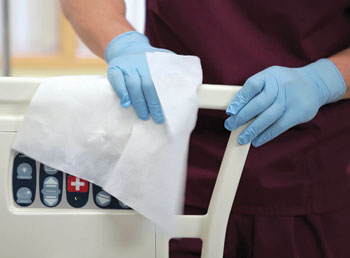 |
|---|
| Photo courtesy of Clorox Healthcare Daily disinfection of high-touch surfaces in patient rooms with bleach wipes can help to prevent the spread of infections. |
One out of every 20 hospitalized patients is likely to contract an infection during care, according to data cited on the Centers for Disease Control and Prevention (CDC) website on health care-associated infections (HAIs). Moreover, a study appearing in the December issue of the Journal of the American Medical Association (JAMA) Internal Medicine found the five most common HAIs cost the U.S. health care system nearly $10 billion per year and Clostridium difficile infections alone accounted for 15.4 percent of total costs.
The good news is that many HAIs are preventable, so facilities need to place a greater focus on implementing infection prevention strategies to break the chain of transmission. This includes more aggressive terminal cleaning procedures in addition to daily cleaning and disinfection protocols. Additional infection control strategies can be implemented to prevent the spread of prevalent and potentially deadly pathogens, such as C. difficile, which can exist in areas beyond the rooms of C. difficile patients to bathrooms and waiting areas.
Terminal cleaning process
The process of both daily and terminal cleaning and disinfecting is of the utmost importance to ensure patient safety and prevent the spread of germs that cause HAIs. However, in the past, there's been some confusion around terminal cleaning — what it is, when it is used and why it is important.
According to the Association for the Healthcare Environment's (AHE's) Practice Guidance for Healthcare Environmental Cleaning, terminal or discharge cleaning refers to the comprehensive, deep cleaning of a patient room at the time of discharge from a health care setting or upon termination of transmission-based precaution policies in place at a given facility. This is meant to render the area safe and ready for the next patient.
The environmental infection prevention strategy must include at a minimum:
- cleaning and disinfection of surfaces touched by patients, health care providers and visitors;
- cleaning of environmental surfaces and visibly soiled surfaces, followed by disinfection in accordance with the facility's discharge procedures.
Despite the important role that terminal cleaning plays in patient safety, many studies have shown that the actual cleaning performed by hospital staff is suboptimal, with only about half of surfaces getting wiped down when they should, according to an article titled "Identifying opportunities to enhance environmental cleaning in 23 acute care hospitals" in the January 2008 edition of Infection Control and Hospital Epidemiology (ICHE).
Other issues involve such improper use of disinfectants as failure to follow manufacturer recommendations for contact times. However, when performed correctly, terminal cleaning can yield high-quality results. For example, one study published in the May 2013 edition of ICHE called "An environmental disinfection odyssey: Evaluation of sequential interventions to improve disinfection of Clostridium difficile isolation rooms" found a C. difficile infection-targeted intervention strategy involving enhanced daily and terminal disinfection with a dedicated environmental services (ES) team led to a dramatic 89 percent reduction in the percentage of rooms with positive C. difficile infection cultures.
Because several pathogens such as C. difficile can persist on environmental surfaces for months at a time, according to a 2006 article published on the BMC Infectious Diseases website under the title "How long do nosocomial pathogens persist on inanimate surfaces? A systematic review," and can be found in non-isolation rooms, thorough cleaning and disinfecting protocols throughout the facility are necessary to prevent the spread of HAIs among patients, staff and visitors.
A hospitalwide strategy
In recent years, C. difficile infections have become more frequent, more severe and more difficult to treat. In the United States alone, 250,000 C. difficile infection cases are estimated annually and C. difficile infections are linked to 14,000 deaths in the United States, according to a CDC report called "Antibiotic resistance threats in the United States, 2013."
C. difficile is a growing problem for health care facilities in part because it can be extremely difficult to control and eradicate. Because C. difficile spores can survive for extended periods, it is imperative to quickly eliminate C. difficile and prevent the spread of this deadly pathogen to other areas of a health care facility. The CDC recommends disinfecting the rooms of patients with C. difficile by using bleach or another disinfectant that is Environmental Protection Agency (EPA)-registered to kill C. difficile spores, according to a CDC Vital Signs online report, "Making Health Care Safer — Stopping C. difficile infections," that was released in March 2012.
In most cases, C. difficile spreads because of inadequate hand hygiene and improper environmental cleaning and disinfection. While isolation precautions are an important part of infection control, the reality is that C. difficile infections are not always immediately and correctly diagnosed. Thus, patients with a C. difficile infection might not be placed under isolation precautions directly upon admission. Additionally, with health care staff and asymptomatic C. difficile carriers wandering the hallways, there are ample opportunities for pathogenic material to spread to surfaces outside the isolation room.
Beyond isolation
Concentrating infection control efforts on isolating patients with C. difficile is not enough, because the smallest lapse in these protocols could lead to cross-contamination with potentially deadly pathogens that can be transmitted facilitywide through contaminated surfaces.
Furthermore, a study published in the Sept. 26, 2013, issue of The New England Journal of Medicine titled "Diverse Sources of C. difficile Infection Identified on Whole-genome Sequencing" found that genetically diverse sources of C. difficile accounted for 45 percent of C. difficile infection cases, suggesting involvement of sources beyond symptomatic patients in the C. difficile transmission process. In addition, another study published in the June 2009 issue of the American Journal of Infection Control called "The Role of Environmental Services in a Collaborative Infection Prevention Model to Reduce Clostridium difficile in the Greater New York Region" found that C. difficile spore cultures are found facilitywide, as 33 percent of non-C. difficile rooms tested positive for C. difficile.
These studies suggest that the use of sporicidal disinfectants would be advantageous in areas beyond C. difficile patient rooms in addition to areas surrounding symptomatic patients with C. difficile in health care settings.
Effective control of C. difficile depends on thorough terminal cleaning using products that are EPA-registered to kill C. difficile spores quickly, and meticulous attention to high-risk areas beyond isolation rooms, such as high-touch surfaces in patient rooms, patient bathrooms, waiting areas and intensive care units (ICUs).
In fact, a study published in the November 2011 issue of ICHE called "A Targeted Strategy to Wipe out Clostridium difficile" found that a daily and terminal cleaning regimen of all patient rooms that included ready-to-use, EPA-registered bleach wipes resulted in an 85 percent decrease in hospital-acquired C. difficile infection rates over a 12-month period.
The study design included several unique aspects that the researchers believe contributed to its success, one of which was the fact that all rooms were cleaned daily with bleach wipes, regardless of whether the occupant had C. difficile. The process added little extra time to the ES team's daily routine, but added an extra layer of protection for vulnerable patients.
Key cleaning steps
When performing terminal cleaning, ES professionals can reference the following key steps, adapted from several recommended guidelines, including the Association for Professionals in Infection Control and Epidemiology Guide to the Elimination of Clostridium difficile in Healthcare Settings, the AHE Practice Guidance for Healthcare Environmental Cleaning (second edition) and the Greater New York Hospital Association/United Hospital Fund Reducing C. difficile Infections Toolkit.
Practice hand hygiene and use personal protective equipment (PPE). When preparing to enter a known or suspected C. difficile room, ES staff first should perform hand hygiene per their hospital's hand-hygiene policy and then don PPE such as gloves, gowns and masks before entering the room.
Clean high-touch surfaces. ES staff should begin by cleaning high-touch surfaces with an EPA-registered sporicidal disinfectant. High-touch areas include door handles and knobs, light switches, call buttons, tray tables, bedrails and phones.
Dust the room. Staff should follow their facility guidelines for a cleaning path, such as cleaning clockwise, top to bottom. They should start with overhead lights. Next, they should damp dust the television, television stand, lights, bed frame, mattress covers, pillows and blood pressure cuffs and remove unused linen and other such items.
Clean the bathroom. It is important to remember that all patient bathrooms are high-risk areas frequently exposed to potentially infectious materials including C. difficile spores. Careful cleaning and disinfection with an EPA-registered sporicidal disinfectant should be included as part of terminal cleaning in all patient bathrooms. Staff should pay careful attention to disinfecting bathroom surfaces such as doorknobs and handrails, mirrors, tubs and showers, faucets, sinks and toilet levers, surfaces and seats.
Clean the floors. After cleaning the bathroom surfaces, the floor should be cleaned, first by dust-mopping and then wet-mopping. After daily floor cleaning is complete, staff should exit the room and remove trash, mops and soiled curtains and linens. They should also discard wipes and cloths and dispose of PPE materials.
Prep for the next patient. After terminal cleaning is complete, staff should wash hands with soap and water and re-enter the room to remake the bed with clean linens, replace pillows, mattresses, pillow covers and mattress covers as necessary. They also should replace privacy curtains.
An enormous impact
Environmental hygiene is a vital part of infection control, and ES professionals have the potential to make an enormous impact on patient safety by achieving excellent disinfection using hypochlorite-based products for terminal cleaning and by focusing on such high-risk areas as bathrooms, waiting areas and ICUs.
Sarah C. Bell-West, Ph.D., is a scientist at Clorox Professional Products Co. She can be reached at Sarah.BellWest@clorox.com.
More resources on terminal cleaning
For additional recommendations regarding terminal cleaning procedures, the following guidelines are available online. Environmental services professionals are encouraged to access them.
• Association for Professionals in Infection Control and Epidemiology Guide to Preventing Clostridium difficile Infections: http://apic.org/Resource_/EliminationGuideForm/e3a85b7e-7ad8-4ab6-9892-54aef516cf10/File/2013CDiffFinal.pdf.
• Association for the Healthcare Environment Practice Guidance for Healthcare Environmental Cleaning (second edition): https://ams.aha.org/EWEB/DynamicPage.aspx?WebCode=ProdDetailAdd&ivd_prc_prd_key=529ab0ff-718f-401d-8433-175d01bef546.
• Greater New York Hospital Association/United Hospital Fund Reducing C. difficile Infections Toolkit: http://gnyha.org/ResourceCenter/NewDownload/?id=3864&type=1.
• Clorox Healthcare Clostridium difficile Prevention Tool Kit: www.CloroxHealthcare.com/cdiff.





